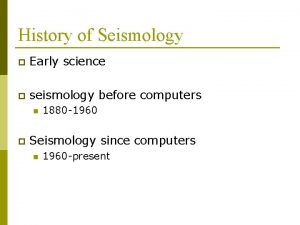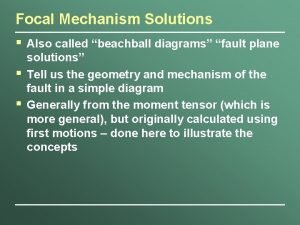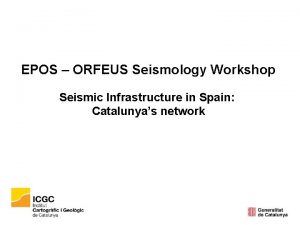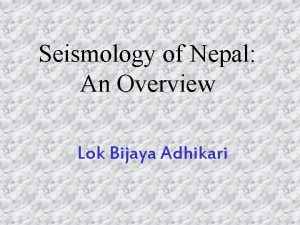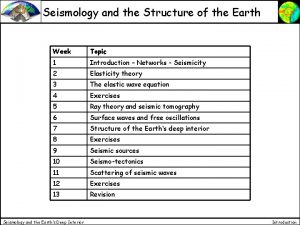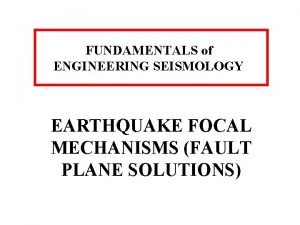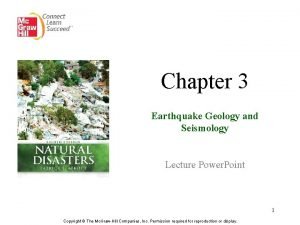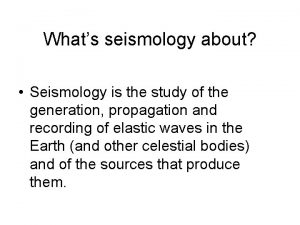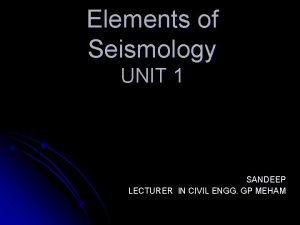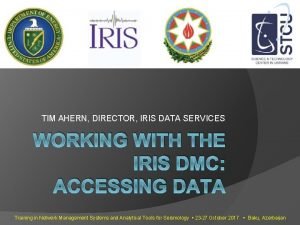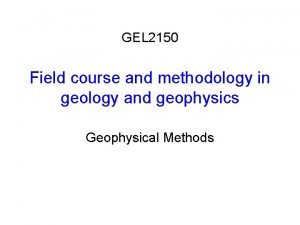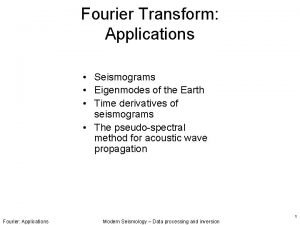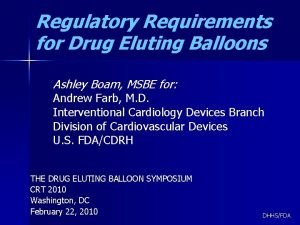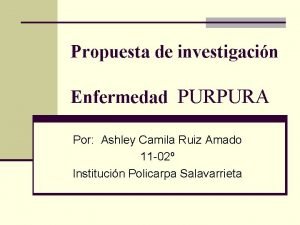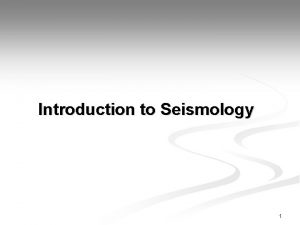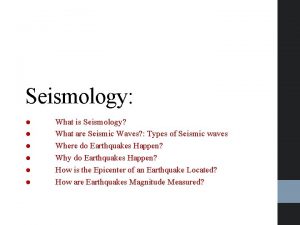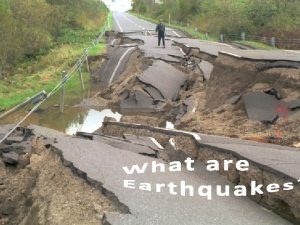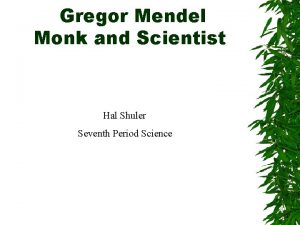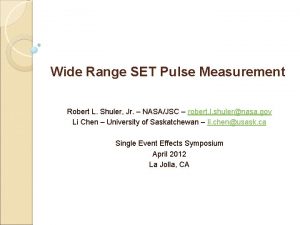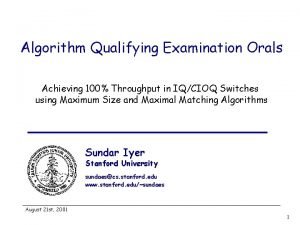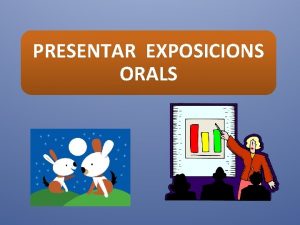INTRODUCTION to SEISMOLOGY Ashley Shuler Orals Prep 2008






























- Slides: 30

INTRODUCTION to SEISMOLOGY Ashley Shuler Orals Prep 2008 -2009

What is Seismology? v v v The study of wave propagation and what it tells us about the structure of the Earth and the physics of Earth’s deep interior. We study earthquakes which radiate seismic waves that travel throughout the Earth, causing ground motion that is measured on sensitive instruments. Sometimes we use explosions (active vs. passive source). Seismology has many applications including hazards, exploration and nuclear monitoring.

Where Do Earthquakes Occur? v v Earthquakes occur on faults and along plate boundaries. The earth’s surface is composed of a small number of rigid plates that drift slowly over geologic time. Their relative motions along their boundaries give rise to earthquakes.

Types of Faults Just as there are 3 kinds of plate boundaries, there are 3 types of faults. v Normal faults occur in extensional environments (rifts, mid-ocean ridges). Thrust faults occur in compressive environments (subduction zones), and strike-slip faults occur in transform environments. v

Earthquakes are not point sources, but occur along planes. Earthquakes have a finite rupture velocity, which is generally. 8*shear velocity. v There hypocenter is where the earthquake begins. The epicenter is the surface projection of the hypocenter. v

Earthquake Sources v v v Earthquakes are double-couple sources. Different types of earthquakes produce different radiation patterns and have different moment tensors. These differences can be visually displayed with focal mechanisms. They are made from the radiation pattern of Pwaves. They are plotted on the lower hemisphere of an imaginary sphere surrounding the source.

v v Focal mechanisms are made from the first motions of earthquakes. There is some ambiguity concerning which plane is the true fault plane. More information is needed.

Elastic Rebound Theory v Earthquakes are caused by the slow accumulation of shear stress and strain that is suddenly released by motion along a fault (producing permanent displacement).

Stress and Strain v Stress is the internal forces between parts of a medium. Strain is related to deformation. These quantities are linked by a constitutive relationship, and through elastic parameters.

Some math… v Homogeneous equation of motion v Vector equation v Solutions give the P and S wave velocities (dependent on density and elastic parameters)

Body Waves v v Body waves travel through volumes of the Earth (P and S waves). P waves have displacement in the direction of propagation (compressional). S waves have displacement perpendicular to the direction of propagation (shear) - can be broken down into SV and SH.

Surface Waves v v v Surface waves are confined to the free surface. Rayleigh waves are radially polarized and are caused by the interaction of P and SV waves at the free surface. Love waves are transversely polarized and are trapped in a surface low-velocity layer. Compared to body waves, they travel slower and have less amplitude decay. Surface wave velocities are frequency dependent (dispersion). In general, longer period waves travel faster because they “feel” deeper.


Phase Identification on Seismograms v v P wave first, mostly on vertial. S wave later, on horizontals. Love wave later on transverse. Rayleigh wave last on vertical and radial.

Waveform Notes v v In a seismogram, we are seeing a convolution of the source-time function with the Earth response and the instrument response. We see body wave phases which travel at certain velocities, and surface waves which travel at different speeds depending on frequency. Phase velocity - speed of single phase (frequency) Group velocity - speed of wave packet (envelope)

Normal Modes v v v Any finite solid will resonate at certain vibration frequencies. The Earth has spheroidal and toroidal modes. Any wave motion within the Earth may be expressed as a sum of normal modes with different excitations. This representation is unique.

Ray Theory (good approximation, but doesn’t fit everything) v v v We often consider rays instead of wavefronts. Rays are perpendicular to wavefronts and obey Snell’s Law (sin theta/v=constant) Because compressional and shear velocities increase as a function of depth, rays turn. If there is a low-velocity zone, we can get shadows.

Travel-time curves Traveltime curves are created by picking phases from seismograms recorded at varying distances. v These tell us about Earth structure. v

What happens at boundaries? Waves can be transmitted or reflected at boundaries. The reflection and transmission coefficients depend on density, wave speed, and angle of incidence. v Waves can also be converted. P can convert to SV and vice versa. v

The amplitudes of waves change as they propagate. If the area increases, the amplitudes decrease (geometrical spreading). v The amplitudes also depend on the impedance (product of density and wavespeeds). v Energy is also lost to attenuation through anelastic processes such as internal friction. v

Magnitude Scales v v v First done in 1935 by Richter. The Richter scale was empirical, and not related to the source. It saturated at high magnitudes. Today we use the moment scale (moment is the product of rigidity, displacement, and fault area). A M 7 earthquake releases 32 times more energy than a M 6 earthquake, and 1000 times more energy than a M 5 earthquake.

Gutenberg-Richter Relationship v v v There is a relationship between the magnitude and the total number of earthquakes in any given region and time. Log N = A -b. M B is typically 1. This means that there are 10 M 3 earthquakes for every M 4 earthquake, etc.

Seismic Intensity v v Another measure is intensity, which describes local shaking as determined by damage to structures and perceptions of people who experienced the earthquake. This is measured on the Mercalli scale from I to XII.

Earth Structure Seismology allowed us to determine the presence of the core (absence of direct P and S arrivals at source-receiver distances greater than 100 degrees). v It also allowed us to determine the presence of a solid inner core (reflections from inner core boundary in shadow zone). v We know the outer core is liquid because it casts shadows in S-waves (shear waves do not propagate in fluids). v

P and S wave velocities v v v Rapid velocity increases in upper mantle, transition zone with mineralogical phase changes (410 and 660 km), gradual increase to CMB At CMB, P wave velocity drops and S velocity goes to zero. P velocity increases with depth due to increased pressure/temperatue P and S wave velocities increase with depth in inner core

Reflection Seismology v v Mostly used in oceans and industry. Large numbers of sources and receivers at short, regularly spaced intervals. Looking for changes in velocity or density Will be discussed by Milena!

Tomography v v v We often want to invert traveltimes or full waveforms to get 3 -D velocity structures. This is complicated by noise, limited data, nonuniform distribution of sources/receivers, location/timing errors. In tomography, we set up a grid, and the travel time is the sum of the product of distance and 1/velocity through each gridpoint on the raypath from source to receiver.

Earthquake Location v v Earthquakes are treated as point sources during location. A location can be approximated using S-P traveltimes at a few stations. From this guess of location, depth and origin time, we compare the predicted arrival times to observed. Perturb and Iterate. There are tradeoffs between depth and origin time.

Instrumentation v v Early seismographs were pendulums sensitive to ground motion (velocity). Modern seismographs are electromagnetic masses on a spring. The voltage required to keep the mass in place is proportional to velocity. We use broadband seismometers with a broad dynamic range. Earthquakes are detected and located within a few minutes of occurring in many cases. Digital data is freely shared among many nations. There is excellent global coverage that is always improving (both permanent and temporary stations).

Can we predict earthquakes? Only in a long-term statistical sense (ie 30% chance of having M 7 or greater in the next 10 years) v Many seismologists doubt we will ever be able to predict earthquakes within a potential evacuation period - too complex, too many variables v
 Suspending agent imparts … *
Suspending agent imparts … * 2008 2008
2008 2008 Seismology timeline
Seismology timeline Normal fault beach ball
Normal fault beach ball Orfeus seismology
Orfeus seismology Seismology nepal
Seismology nepal Seismology
Seismology Beach ball earthquake
Beach ball earthquake Seismology
Seismology Whats seismology
Whats seismology Elements of seismology
Elements of seismology Seismology
Seismology Gel geophysics
Gel geophysics Seismology
Seismology Vulva
Vulva Hazmat for dummies
Hazmat for dummies Ashley fuller md
Ashley fuller md Dr ashley kerr
Dr ashley kerr Ellena ashley
Ellena ashley Ashley nissenbaum
Ashley nissenbaum Ashley boam
Ashley boam Ashley speegle
Ashley speegle Ashley camila
Ashley camila Ashley ferrante
Ashley ferrante Ashley dorsey
Ashley dorsey Ashley cutcher
Ashley cutcher Ashley campion
Ashley campion Ashley barr hawaii
Ashley barr hawaii Girl interrupted summary
Girl interrupted summary Ashley mathura
Ashley mathura Simplified drawings exaggerated vibrant colors
Simplified drawings exaggerated vibrant colors


